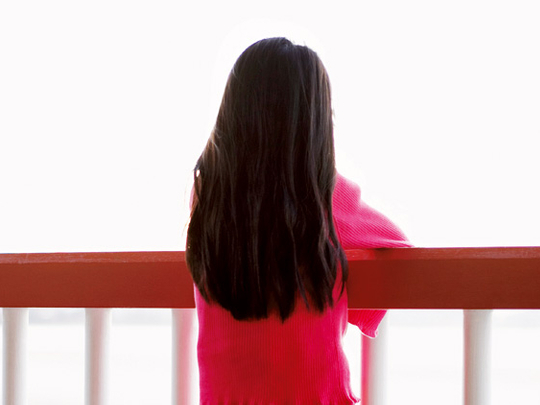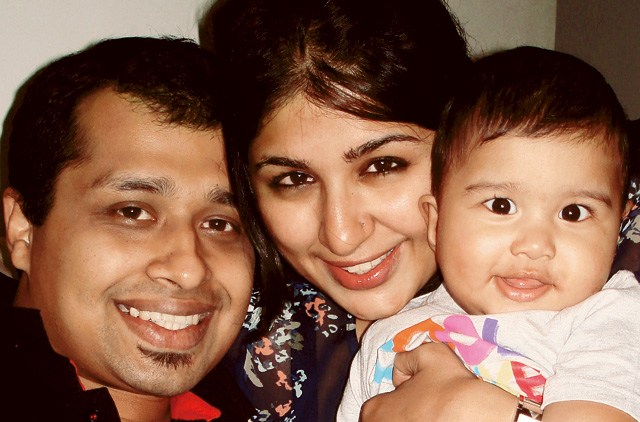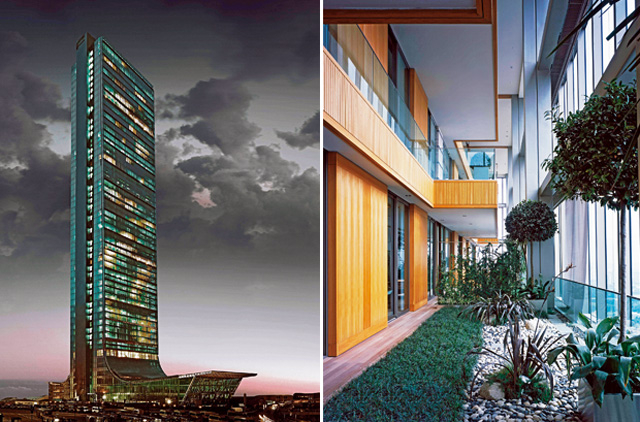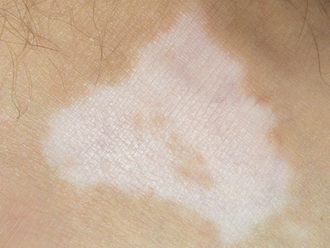
Ever since architects began designing buildings that touch the clouds, concerns have been raised about people, particularly children, accidentally falling from them. The number of children in the UAE who have recently tumbled out of high-rise buildings has forced people in the community to pay attention to the problem.
Nearly two dozen children have fallen from flats over the past couple of years, and only one - six-year-old Dunia Reda - miraculously survived after falling out of her family's sixth-floor apartment in Sharjah's Al Nabaa.
These tragedies have encouraged parents to take precautions to prevent these incidents in the future. Meanwhile, the authorities have also initiated new rules for preserving the safety of children living in towers.
Like most parents in the UAE, Zachariah Joseph and his wife Eleyah have been disturbed over the number of children who have plummeted to their deaths.
As parents of six-month-old Jay, the couple has been diligent about childproofing their apartment in Dubai. "We are doing as much as possible to ensure our house is as safe as can be,'' Eleyah says. To that end, they have been checking out the various safety products available in stores like Babyshop to childproof their home.
The role of design
While strict international design and safety guidelines are being followed in the UAE, sadly accidents continue to occur.
Alf Seeling, principal at leading Dubai-based architecture firm Woods Bagot, says architects are conforming to international building codes to make their designs as safe as possible.
"For instance, balcony balustrades have to be a minimum of 1,100mm. For residential areas, we specify a height of 1,200mm, to make it even safer. Building owners and designers should know that there ought to be no fixed furniture or features that can compromise the 1,100mm height required for balconies - meaning there should be no ledge, horizontal bars or surfaces that can give children a foothold. Balustrades should have vertical bars that are no more than 100mm apart, otherwise children can get their head stuck in."
Even a window opening of 100mm is enough for children to wriggle through. "Windows pose the same danger as balconies and possibly even more so, as they are unsuspecting," he says.
"The opening can be restricted with something as simple as a chain and two screws. But there are also safety items that you can buy from the store. We tend to use a window catch as part of the window opening system so a child can't get out.
"The trouble is that these kind of devices can fail over time. You can put bars on windows but retrofitting is difficult once people have moved in," says Alf. Bars are also a fire hazard as it restricts access for fire fighters.
"When it comes to occupants of a building, there needs to be an education process. Accidents can happen in a matter of seconds. If you have young children, use outdoor furniture that can be folded and put away when the balcony is not being used. Potted plants sitting on the floor should certainly not be put on the balcony where children can climb," he says.
Ironically, incidents of falls from buildings in the UAE are more frequent in the cooler months, presumably because windows are more likely to be left open. So they need to be closed once children are around.
Safety and security are not the only matters of concern when living in high rises. Hassan Radoine, architect and chairman of the Department of Architectural Engineering at the University of Sharjah, believes there are several drawbacks to apartment living in high-density urban neighbourhoods.
He explains that a cluster of tall buildings next to each other prevents sunlight from entering the apartments. The narrow spaces between buildings and the fact that apartments are often facing each other means that curtains are drawn all day for privacy.
"The lack of exposure to sunlight worsened by the high levels of humidity can impact residents' well-being," says Hassan For apartment buildings to be affordable, designers use modular building techniques, where elements are precast, pre-assembled and then slotted into place, making for faster construction. The system is faster, more efficient and results in uniformity across a building, but it does have its drawbacks. "A façade on the 80th floor is treated exactly like the one on the first floor," Hassan adds. But when it comes to balcony and window design, this could be unsafe.
Resident responsibility
Alf says that older buildings may have been built to safety codes that were relevant at the time of construction but those are not as strict as the codes today. So until buildings are updated, it's up to tenants to be more safety conscious, he says.
"Most balcony doors tend to have just a latch, which a child can open easily. Residents should consider using bigger latches for balcony doors that can be fixed higher to secure doors," Alf says. "When you have young children you have to be conscious of safety. One way to control the problem is to not allow children to get on to the balcony."
A Sharjah resident and mother of two Santa Fonseka has done exactly that. Living on the 28th floor in an Al Nahda, Sharjah, high rise, Santa says she barred access to the window in her children's bedroom by putting up a shelving system in front of it.
While the window can be opened for ventilation, it isn't wide enough to endanger her children. The kids are also restricted from entering the balcony of her flat.
"Quality control for buildings should be based on a list of requirements derived from the region and not imported from other environments with different conditions and criteria," says Hassan.
He proposes that architects and engineers create emergency plans and safety scenarios as are practised in the engineering of airplanes - with emergency exits, emergency plans and catastrophe alerts for residents.
"The risk posed by the current height of high-rise buildings is no different from being in a plane, given they reach heights of 700 to 1,000m. I am not against tall buildings per se, but I am advocating that they be designed according to a certain standard of comfort and security for the user," Hassan says.
Indeed all professionals involved in the building process share a responsibility where human lives are concerned.
The American Academy for Pediatrics, in a paper on falls from heights, says that there are factors that contribute to fall injuries that range from neurological disorders, such as seizures, developmental delay, hyperactivity and parental neglect. The families of children who have died in falls are more likely to have experienced certain social and demographic factors that result in inadequate child care.
While this study is specific to the American context, there are parallels with the UAE. In addition to some shared social and demographic factors, many expatriate families have moved from rural settings and are not fully sensitised to the dangers of living in high-rise apartments.
In Abu Dhabi this January, a three-year-old toddler was rescued before a disaster could take place by a police officer who saw her sitting on a ledge outside her family's apartment window. One month later she tried it again, this time the consequences were fatal.
Child-care options
The problem of children being left unsupervised at home while parents are at work also highlights other issues. "There is a need for more affordable child-care options for working parents," says Santa.
"Children left alone in flats often look out windows for stimulation. Increasing the number of playgrounds for children in densely populated areas will help them expend their energy. It will also serve to tackle the other pressing issue of child obesity."
Alf agrees. "In Europe and Australia there have been very long education campaigns so people are more aware of the dangers," he says "Education for parents is key, especially in a multicultural environment such as the UAE. While schools can create safety campaigns for children, community outreach programmes in several languages will educate parents on safety and reduce the incidents of falls."
Local municipalities care
Making buildings safer for children requires a multi-pronged approach, involving several agencies. Building codes and legislation that require building owners to install window guards in high-rise family dwellings and stipulate minimum heights for safer balconies are under way in Sharjah and Abu Dhabi.
Last month, Sharjah Municipality announced that new specifications designed to make high-rise residential buildings safer for children will be implemented within three months.
The codes, to be published in the new edition of Sharjah Municipality's Regulation Book, specify that balcony walls must be at least 1.2m instead of 1m and child-proof windows can only be opened to a maximum width of 10cm without assistance from an adult.
Supported by a media campaign and municipal inspections to ensure compliance by owners, the municipality hopes that the new regulations will make Sharjah's residential buildings safer.
Abu Dhabi has followed suit with its Department of Municipal Affairs (DMA) directing owners of residential buildings to install protective devices on windows and openings, so they do not open wider than 10cm.
Windows and openings that are less than 1.5m from the floor must also be secured by protective devices. Building owners have six months to comply with the new requirements, before authorities begin inspections.
Some architects around the world are working on making high-rises safer and more suitable for families by providing spaces for greenery and safe places to play. Architects like those at Le Corbusier saw the potential to expand vertically while creating more public and green spaces for families.
Architect Melkan Gürsel Tabanlıoğlu, who designed Turkey's highest building - the Istanbul Sapphire, a 52-storey residential building, with leisure and shopping facilities - is also working to create other safer and greener high-rise buildings. Istanbul Sapphire has a shell enclosing the apartments and there are gardens on every third floor. This reduces the need for children living in the building to play on the balcony.
"Vertical living in densely populated places is definitely the reality of 21st-century urban planning," Melkan says.
"In fact, tall buildings close to the city centre provide better living and social standards compared to developments of urban sprawl."
Since this is our reality, safety considerations are of the utmost importance, especially where children are concerned.
Although international safety regulations are in place in the UAE and the authorities are working to ensure the safety codes and regulations are properly adhered to, accidents still can and do happen. It is up to parents and carers to ensure that children are safe at home at all times.
Preventing injuries from falls
- Small children are to be supervised at all times, especially if windows and doors are open.
- Ensure sliding windows and doors do not open more than 100mm by installing child-proof locks. Mesh screens on windows can keep insects out, but are not sturdy enough to prevent falls.
- Prohibit children from playing on balconies, especially if they have a balustrade height below 1,100mm.
- Avoid placing furniture near windows.
Things to consider when making your home safer:
- Use safety gates around staircases to prevent your child from climbing up the stairs without adult supervision. Using corner and edge bumpers will help avoid injuries if your child is learning to walk.
- Fit safety gates on door frames to secure areas for toddlers.
- Use door stops and door holders to prevent injuries from doors closing on little fingers.
- Fix sliding door and window blocks so they can open only to a limited extent.
- l For windows that open inwards, outwards or upwards, a window catch, available for around Dh35, reduces the risk of a child falling out.
- Always consult the municipal authorities before making any changes to the structure of the building.
- Detergents and cleaning agents can pose a huge risk to children.
- (Information courtesy of Babyshop)












